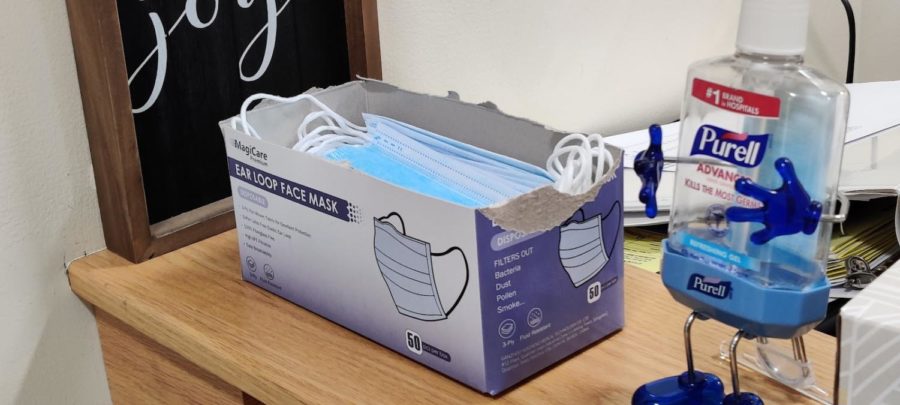Masks: Friends or Foes?
A critical retrospection of mask regulation at school during the Covid-19 pandemic
December 1, 2022
Masks: Friends or Foes?
Several weeks ago, President Biden declared that “the pandemic is over.” While this isn’t technically true—the White House quickly clarified that the government still has COVID-19 officially designated as a Public Health Emergency—this is a testament to the fact that in a lot of ways, life has returned to pre-pandemic days. In February, following an announcement revealing the date of expiration for the state-wide mask requirement, the Plymouth School Committee held an open and virtual meeting in response. The very next day, it was announced that the committee had unanimously supported the recommendation to lift the mask mandate in our school system.
It has been months since we stopped wearing masks everywhere we go, and the pandemic has disappeared into the background of our lives since. In light of this reality, it’s time for us to critically consider the pandemic regulations and the way they affected students at Plymouth South in retrospect. Over two and a half years after the district declared the “two-week” break from school, what can we say about the restrictive mask regulations we dealt with throughout the global health crisis?
The Social Impact of Masks
While wearing a mask seemed strange when we first came back to school the following September, students adapted to their new lives quickly. Soon enough, daily masking became just another part of student life in Plymouth. Although we did adjust to the change, the impact that masks had on our social interactions is worth recognizing.
A study from last year showed us how masks could influence our social interactions negatively. Humans, by our nature, mimic the expressions of others in order to reproduce their emotional experience in ourselves during conversation. This involuntary process promotes our ability to socialize more empathetically. With masks obstructing our faces, we weren’t able to distinguish positive interactions and share emotions as effectively. Furthermore, according to psychologist Rebecca Brewer, we process facial expressions as a whole, not as individual features. Consequently, when a portion of a face is obstructed, the holistic processing of an expression is disturbed. With the requirement finally gone, the quality of our communication improved in a possibly unnoticed but meaningful way.
The Value of Masks
If they impacted us negatively, why did we use masks in the first place? The SARS-CoV-2 virus is airborne; highly transmissible through the air. Those who are infected release droplets of respiratory fluids through various forms of exhaling: breathing, singing, speaking, and especially coughing and sneezing. Those who breathe in these particles can become the next infected individual, who can then continue to pass on the virus. The aerosolized coronavirus remains in the air for as long as three hours, and can accumulate over time.
As a result of this, the widespread utilization of masks became an effective way to reduce the spread. As claimed by several studies listed by the CDC, masks can—to varying degrees—block these infectious and airborne particles. The circumstances of the pandemic meant that not masking at school was simply not an option. This, of course, had to be the case because masks are most effective with high compliance. With the establishment of enforced regulations, much better results could be achieved.
Fun Fact: Respirators are devices made for protection against hazardous matter in the air, including gasses, dust, fumes, and of course, airborne bacteria and viruses. The Center for Disease Control and Prevention (CDC) ranks disposable surgical masks and KN95 respirators over cloth products for preventing the spread. The highest protection is provided by (NIOSH-approved) N95 respirators such as the one pictured above. Ms. Conroy could be seen using these regularly last year.
The Future of Masks
Fun Fact: It was a regular occurrence for many Asians to mask in public areas, even before the pandemic. Masking was especially common by the ill. The image above shows two individuals using masks on the Great Wall of China prior to the pandemic
With so many students habituated to masking over time, we could see masks become a small, but permanent part of some of our lives. Countless East Asian nations had already been using masks prior to the pandemic. Especially for those who were ill, wearing a face covering wasn’t considered out of the ordinary. Taking into account the voluntary use of masks by other nations, it would be fair to say that the regulations weren’t so bad. Perhaps, masks can continue to serve a purpose for students, and even the rest of society, moving forward. Although not everyone will permanently adopt masks as a form of protection from smaller outbreaks, as Dr. Sheela Shenoi has said, “mask-wearing will hold in the U.S.” In favor of protecting others from sickness, students at Plymouth South should become among those who do consider adopting masks in times of sickness.
